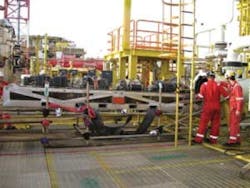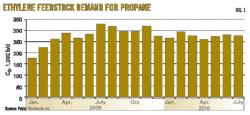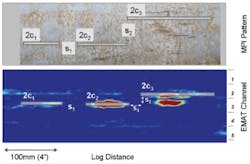Modifications to the Weyburn CO2 injection scheme required a detailed engineering approach followed by construction work carried out by multiple companies.
The first part of this two-part series (OGJ, Nov. 16, 2009, p. 43) on debottlenecking the Weyburn injection scheme described the design parameters; this concluding part covers the steps involved in the detailed design and construction.
P&IDs
Upon completion or near completion of the new process flow diagrams and material balances, as discussed in Part 1, the next step involved revision of the plant's existing piping and instrumentation drawings (P&IDs). The new P&IDs showed all new equipment such as the pumps, heat exchangers, and other skids.
During the preparation of the P&IDs, the detailed work also included the sizing of all secondary equipment and interconnecting piping and cable.
After completion and approval by Encana of the P&IDs, further detailed engineering followed.
Acoustical design
The detailed engineering required an acoustical analysis on each of the newly reconfigured reciprocating compressors. The analysis used an API 618 Design Approach 2 (M.2-M.4).
The pulsation analysis also looked at the existing pulsation bottles and orifice plates and found that the bottles were reusable but new orifice plates were needed.
The mechanical analysis recommended:
• Dynamic rigid supports on the first and second-stage suction piping.
• Third-stage suction bottle rigidly supported from a stiffened existing A-frame support.
• Rigid support for all scrubbers to maximize the mechanical natural frequency, which is a potential vibrations source.
• Adjustment of the discharge bottle support to maintain preload contact.
During start-up, a piping vibration survey was performed.
Interconnecting piping
Based on the P&IDs and the acoustical analysis, the design work created the detailed 3D piping models for fabricating all new spools and interconnecting piping.
The plant piping 3D layout for the restaged compressors, exchangers, and pumps identified the valves and instruments to make the turnaround piping installation and instrument replacement more efficient and easy.
After completion of the 3D piping design, the next step preformed a stress analysis on the piping with Caesar II software. This required importing the 3D Autocad model and analyzing all the new headers with the program.
The analysis passed all the stresses to which the piping would be exposed, such as stresses caused by temperature, pressure, and hydro testing. All stresses were less than the ASME petroleum refinery code for pressure piping (B31.3) allowable stresses.
The initial design incorporated flexibility and expansion loops for avoiding potential stresses.
Electrical equipment
Concurrent with the detailed mechanical design, the work also included the electrical and instrumentation detailed design.
The detailed design work entailed frequent meetings of the civil, electrical, and mechanical groups for identifying interdisciplinary mismatches or changes. Produced were electrical single line, area classification, and junction box drawings
The scheme connected the Reda pump electrical motors via two 4,160-v to 480-v transformers from the 4,160-v main to four variable-frequency drives. Each train has two dedicated motors with the two motor variable frequency drives (VFDs) controlling the pump output via pressure on the pump suction or last stage K701 compressor discharge.
The injection pumps are in the two long buildings in the lower left. The pipe rack coming out of pump buildings goes towards the aerial compressor coolers. Two variable-frequency-drive buildings are to the right of the pump buildings. Two transformers are behind the VFD buildings. The Heatric exchangers' open skid is visible behind the pump-skid building (Fig. 1).
The control worked well, keeping the pump synchronized with the reciprocating compressors.
Fig. 1 shows the construction area.
Skids
Skid design started after completion of the basic design.
The pump building skid was the most complex and compact. It included the pump and motor, interconnecting piping, electrical hookup, instruments, lifting and transport provisions, maintenance access, and operations interface.
Fig. 2 shows the inside of the pump building.
The Heatric exchangers have an open skid design; however, running the piping was a challenge because of the high-pressure piping and inlet strainers. The exchangers require two strainers per stream, one in operation and the other on standby for use while cleaning and maintaining the other.
Fig. 2 of Part 1 (OGJ, Nov. 16, 2009, p. 45) shows the complexity of the strainers and heat exchanger open skid.
The VFD skids have minimal complexity except for the area classification of the transformer and process equipment as well as for the VFD spacing and enclosure requirements.
Civil engineering
The design included installing all equipment, skids, pipe rack, and supports on piles. The skid foundations consisted of I-beam channel and other structural steel.
Turnaround planning
The project called for developing a plan for the plant turnaround that involved tying in the piping and electrical equipment for the compressor recycle and pump upgrade.
Fig. 3 shows the turnaround schedule for the mechanical work to tie in compressors K701-1 and 2 after the installation of all equipment skids and interconnecting piping and wiring.
The electrical and instrumentation work was not included in the schedule. This was because the electrical instrument tie-ins were not on the critical path. The plan generated lists with the tasks to complete, one for electricians and the other for instrument technicians.
The 3D mechanical drawings had labels showing the location of the instrument electrical tags. This enabled the construction technicians not familiar with the plant to plan their activities by physical location. These 3D drawings proved useful throughout the project.
Compressor blowdown
Fig. 4 is a simplified schematic of a single compression train to help visualize the blowdown procedure.
In the event of a plant emergency, the standard procedure requires blowing down the gas to the plant flare. This entails the closing of the inlet and outlet emergency shutdown valves and depressuring the piping and equipment to the flare.
The gas can form hydrates when it is blown down from high pressure as in the EnCana Weyburn injection system (15,300 kPa-g) and is water saturated or wet. In addition, it is extremely hazardous to try to contain this gas at high pressure. With any minute temperature change, the gas can expand and overpressure the piping or vessels.
Falcon performed the blowdown calculations to avoid hydrates or containing the gas for long periods.
Fig. 4 shows by means of a color schematic the piping and equipment steps involved in the blowdown. Note that during blowdown, the compressor cylinders act as check valves until their suction and discharge pressures equalize. The gas also can be heated before the blowdown valve (BV-1) to avoid hydrates.
The following steps summarize the partial blowdown sequence of the two trains in parallel to a partial blowdown to 500 kPa (75 psi). It is possible to blow down one train while the other remains in operation.
• Step 1 involves activating a blowdown valve (BV-1) instantaneously for blowdown conditions. Regions blown down are the full discharge of the third stage of compression (cooler), the recycle line and valves, recycle and BP-2 to the third stage of compression, both Reda pumps, and all suction lines including the strainer and heat exchanger. The starting pressure of these regions is 8,412 kPa (1,220 psi) and the final pressure is 6,205 kPa (900 psi).
• Step 2 opens the valves BP-1A (Reda pump bypasses) and blows down the combined region from the check valve to ESD-2 on the Reda pump outlet and the remaining inventory from Step 1. One should note that the pump discharge pressure is 15,275 kPa (2,215 psia) and upon mixing with the inventory left from Step 1, the equalized pressure will be 7,205 kPa (1,045 psia). Next blown down are the combined inventories from 7,205 kPa (1,045 psia) to 4,135 kPa (600 psia).
• Step 3 blows down the third-stage suction, third-stage scrubber, second-stage cooler with associated piping, and second-stage discharge line. The final pressure obtained in this step is 2,415 kPa (350 psia).
• Step 4 blows down the second-stage suction, second-stage scrubber, first-stage cooler with associated piping, and first-stage discharge line. The final pressure obtained in this step is 2,000 kPa (290 psia).
• Step 5 is optional and is for an emergency. Usually blowdown stops at Step 4. Step 5 involves blowing down the first-stage suction, first-stage scrubber, and the piping from ESD-1. The final pressure obtained in this step is 500 kPa (75 psi), the final pressure in the partial blowdown sequence.
Tables 1 and 2 summarize the blowdown sequence pressures, temperatures, and times for depressuring each step up to Step 4.
To prevent hydrates from plugging the blowdown valve BV-1 and the flare lines, the scheme includes a flare heater before BV-1. Gas passes through the flare heater and a temperature indicator controller (TIC) monitors the temperature before the blowdown valve BV-1.
When the low set point temperature and pressure are not met, the valve throttles or closes until the gas heats up to the desired temperature. Using Tables 2 and 3, one can predict the hydrate point (temperature and pressure) and avoid blowing down at a critical temperature for the steps involved in Table 2.
The temperature set points of the TIC are pressure-dependent (measured by a pressure-indicating transmitter) and related to the hydrate temperature at that pressure. Table 3 shows the hydrate temperatures at different pressures.
Construction
EnCana managed the construction at the plant. The company divided the work among four local companies and two Calgary-based companies. All work proceeded quickly and costs were kept on budget. The accompanying box shows a summary of the work performed by each company
Construction and start-up went very well. Only one issue arose during construction. Operations requested to invert the compressor feeding the initially designated respective pump.
This involved a change in the main drawings; however, the skid drawings tags were not changed because construction on the skids started considerably earlier. Subsequently, this led to changing the equipment control and indication wiring between pumps.
The pumps started up and ran smoothly after 2 weeks.
As discussed in Part 1, the pump curves did not reflect the required horsepower per pump and required an upgrade to 600-hp motors.
Lessons learned
Several things were learned from this project.
Designing the injection scheme revealed that the gas behavior of mostly CO2 (76% and above) recycle gas varies considerably for different temperatures. Above the critical point, the design requires specific gravities from reliable and consistent models. Although it is possible to pump the recycle gas in dense phase under certain circumstances, knowing the temperature at which it is pumped is critical because of the rapid changes in density.
The design requires pump curves that accurately predict pump horsepower draw (with the corresponding operating efficiency) and liquid flow-rate for the fluid's specific gravity. If possible, it is advisable to run the pump at the actual conditions of operation and confirm the points on the curve for flow vs. horsepower draw and flow vs. pressure differential (ΔP).
Pumping dense-phase CO2 at the right conditions is much more cost effective than compression. There are some constraints because the process requires a compressor initially to obtain the dense-phase pressure.
The scheme requires a careful study for selecting the optimal cost for the compression-pumping of the recycle gas. Retrofitting a reciprocating compressor requires that restaging is feasible and that the gas have the right specific gravity/dense phase (controlled by the temperature after compression entering the pump).
EnCana operations reports that the reciprocating compressor and pump combination is stable and operates smoothly when the ambient conditions are below 15° C. (60° F.) and easily achieves a flow of 1.134 million cu m/day (40 MMscfd). During the summer months, the pump capacity varies more, and the combination can usually be operated at 964,000 cu m/day (34 MMscfd).
The advantage of reciprocating vs. centrifugal compressors is that reciprocating compressors can compress water-saturated gas. Centrifugal compressors cannot tolerate any water saturation on the impellers.
Printed circuit heat exchangers are sensitive to impurities in the gas. They are prone to fouling easily. The Weyburn project team installed strainers before gas entry into the exchangers. Unfortunately, asphaltenes and other solids contaminate both the purchased CO2 and the EnCana recycle gas. Operations found it problematic to maintain the strainers on line for very long. Because of the operating conditions of both streams (high pressure and high CO2 content), the field considered the strainers almost inoperable.
More Oil & Gas Journal Current Issue Articles
More Oil & Gas Journal Archives Issue Articles
View Oil and Gas Articles on PennEnergy.com







